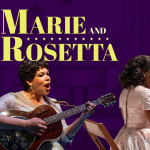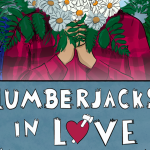Vintage Shopping Guide
Lacy Landre gives us some quick tips to spot genuine vintage clothing just in time for the holiday shopping season.
 Some people will go to great lengths to fake pit stains or add old tags to new garments. I went to a successful Santa Barbara vintage shop this summer that cut all its actual vintage dresses into minis and was trying to pass off sexy pinup girl Halloween costumes as vintage. The manager of a now-defunct Milwaukee vintage store told me she was instructed to cut the labels off tee shirts and secondhand H&M dresses to sell. What is wrong with people?
Some people will go to great lengths to fake pit stains or add old tags to new garments. I went to a successful Santa Barbara vintage shop this summer that cut all its actual vintage dresses into minis and was trying to pass off sexy pinup girl Halloween costumes as vintage. The manager of a now-defunct Milwaukee vintage store told me she was instructed to cut the labels off tee shirts and secondhand H&M dresses to sell. What is wrong with people?
1. Its label, if present. Look on the side seams if it’s not at the neckline. Newer clothing will often have cheap looking screen-printed or thin synthetic-fiber labels. Older things usually have a higher-quality embroidered logo with natural fiber thread, so check the backside. Sometimes it may list the city or state of origin, but if a label says it’s ‘Made in China,’ it’s a sign of outsourcing that didn’t happen on a grand scale until around the 90s.
2. Fonts can give clues to age. Certain labels mirrored popular typefaces of an era, such as the flowery Art Nouveau or Gothic lettering in the 20s-30s, architectural Art Deco during the 30s-40s, modern Futura in the 50s-60s, or cartoony letters in the 60s-70s. Scripted logos are sometimes confusing, so look at the rest of the writing on the tag.

3. An RN number might be present if it was made after 1959. If you want to get more specific, some wholehearted vintage geeks figured out a formula to find a garment’s approximate year of origin.

4. An International Ladies Garment Workers Union (ILGWU) screened label is also helpful. Although they’ve been around since the turn of the century, a monochrome ILGWU tag without AFL-CIO on it came from before 1955, and with AFL-CIO is from 1955-1974. The label changed to red, white, and blue from 1974-1995.

5. A tag with a ‘lot’ size number indicates it was made between 1940-1979, and half sizes were only used until 1970. Also worth noting: with modern vanity sizing, a size 6 today is roughly equivalent to a 60s size 12. Don’t pay attention to sizes; pieces may have been altered and sizes vary by brand. Go by measurements.
6. Garment sizing was not required until 1959.
7. Fabric content labels became mandatory in 1960.
8. Care instructions became mandatory in 1971.
If your prospective garment has no labels, there are other clues such as:
9. Back metal zipper = usually 50s-60s.
10. Back plastic zipper = usually 60s to present.
11. A side metal zipper = usually made between the 30s-60s.
12. A side snap or hook closure usually indicates a garment was made before the mid-30s, as does a button-fly closure for men’s pants.
13. Stitching. Serged seams weren’t found widely in garments until the 50s, although sergers have existed for over 100 years. Keep in mind that older garments were often handmade or may have been altered later; there are exceptions to everything.
14. Fabric. Is it natural or synthetic? Thick rayon and Dacron polyester were used in undergarments and light dresses from the 20s-50s, and nylon, acrylic, and acetate weren’t widely used in clothing until the 60s.
What about online shopping?

15. Just use common sense. Do your research on eBay and Etsy. If a seller isn’t able to tell you what a garment is made of, its approximate (and accurate) age or measurements, move on. Look for quality construction and you’ll get years out of your clothes.
The Midwest is a goldmine for vintage hunters because we have to dress for insane weather changes. We also harbor an army of aging pack rats who never get rid of anything, so there’s more than enough wool to go around. Buy local this season! You don’t even have to leave your computer.
A few noteworthy Etsy shops from Milwaukee who do vintage right:
Antique a.k.a. Annie’s 2nd Hand Chic – you can stop by the physical store off Brady St. at 1668 N. Warren Ave.
Also check out Dime a Dance (1134 S. 1st St.) at the Walker’s Point Antique Center. Analog-only.
Further reading:
Sammy Davis Vintage – Great tips; doesn’t read like an instruction manual.
Vintage Fashion Guild – Check out their label archive.
Fashion-Era – Borderline-obsessive person’s fashion history site.


























nice work lacy!
I’m so happy I found you. I am also a retro girl and insist on authentic pieces. I am composing a post on vintage shopping on my blog and will link it to your post.
Thank you so much. Valuable info here.
DebraLee Darling
Great article!
[…] Threads: Vintage Shopping Guide I went to a successful Santa Barbara vintage shop this summer that cut all its actual vintage dresses into minis and was trying to pass off sexy pinup girl Halloween costumes as [see also thrift store ] vintage. The manager of a now-defunct Milwaukee vintage store told me she … Read more on ThirdCoast Digest […]
[…] and promoting vintage garments for years. Nevertheless, purchasing … Read a lot more on ThirdCoast Digest Posted in Vintage Clothing Stores | Tagged Clothing, Latest, News, Stores, […]
Thank you for posting this : that’s really helpful !!!
Outstanding article, excellent research, great illustrations. Jan read it carefully, and will pass it on to friends who buy vintage. Congratulations.
Thank you Lacy, for your article-it is very informative and well balanced! I am also a vintage clothing lover. I am from Toronto and I have very good experience with Toronto vintage shops here. There is quite many of them in Toronto and what is more important they offer exactly the vintage clothing having qualities you described. Staff is very knowledgeable about what they sell in general. It is great experience for me always to go to one of them. I really recommend visiting them.
Excellent article, Lacy! I bought my first vintage piece in Santa Barbara back in 1987–& I’m sure whatever I was wearing that day to shop in would now also be oh so ’80s vintage (probably leg warmers, shoulder pads & a hair scrunchy, haha). What I bought was a beautiful Jackie O style 2 piece wool suit with fur collar 3 quarter sleeve jacket with cloth covered buttons and skirt with metal zipper, with label in tact, so your advice on the detail to look for is spot on. In the years since I’ve worn delightful vintage hats, coats & clothes with Dime a Dance being a local favorite (fabulous quality) and BVEN Boutique on Brady (www.bvenboutique.com/ and Lelas in the 3rd Ward(www.lelaboutique.com/. If you want the “vintage” look with the beauty of new fabrics-definitely check out BVEN Boutique’s line called “Stop Staring” with Hollywood head-turning designs in a wider range of sizing than often can be found in authentic vintage only.
Thanks Tamara! It was so much fan having my brick and mortar boutique for 10 years. I am excited about my new online venture featuring recycled and created eclectic fashion, art and jewelry at http://pippy.co !